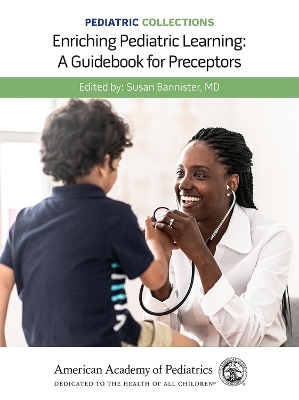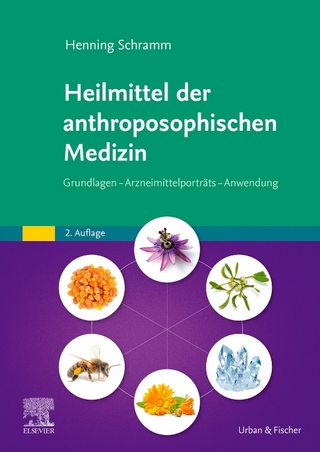
Pediatric Collections: Enriching Pediatric Learning
American Academy of Pediatrics (Verlag)
978-1-61002-582-9 (ISBN)
Pediatric Collections offers what you need to know - original, focused research in a snapshot approach.
COMSEP, the Council of Medical Student Education in Pediatrics, is a community of pediatric educators committed to supporting each other and delivering excellent pediatric education to medical students. The articles and commentaries in this Pediatric Collection, titled Enriching Pediatric Learning: A Guidebook for Preceptors, have been written by COMSEP members, and the principles of our organization have driven much of their work. COMSEP’s guiding principles articulate what its members believe to exemplify excellence in medical student education: Teaching should be excellent, innovative and scholarly; The learning environment should be safe and enjoyable for all; and Patient/family centeredness, teamwork, professionalism, humanism, and service are essential core values of pediatrics. Another principle is that Pediatric medical student education makes all students better doctors. We recognize that not everyone whom we teach will become a pediatrician, nor will they ultimately care for children in their practice. But we also recognize that many of the skills they learn and the behaviors they observe while working with children, families, and pediatric professionals will influence their growth and may, ultimately, affect the physicians and surgeons they become. The 35 articles in this Collection have been grouped by themes and together they describe skills and strategies to improve clinical teaching. The authors and editorial board have tried to imagine the clinical practice of a busy preceptor in a variety of settings—rural or regional or urban practice, community hospital, academic center—and have tried to provide an article that is succinct and captivating with practical tips that can be put in to use that day with a trainee. We hope that this Collection, too, will be a practical resource that will support preceptors and educators in their quest to teach, assess, and inspire the medical students with whom they work.
The American Academy of Pediatrics is an organization of 67,000 primary care pediatricians, pediatric medical subspecialists and pediatric surgical specialists dedicated to the health, safety and well-being of infants, children, adolescents and young adults. The AAP is the largest pediatric publisher in the world, with a diverse list of resources that includes essential clinical and practice management titles and award-winning books for parents. Susan Bannister, a Professor of Pediatrics at the University of Calgary, has been a member of the Editorial Board of the Council on Medical Student Education in Pediatrics (COMSEP) feature in Pediatrics since its debut in 2010. In this role, her goal has been to write and edit manuscripts that are accessible and helpful to preceptors and provide these clinical teachers with tools and tips to improve student learning in their busy pediatric practices. Her medical education research focuses on what influences learners to see and seize technical skill learning opportunities in the clinical setting. She has been a member of the Pediatrics Editorial Board since 2016.
Chapter 1 - Medical education matters: Pediatric clinical teachers can inspire the next generation of doctors by Susan L Bannister
Bannister SL, Raszka WV, Maloney CG. What makes a great clinical teacher in pediatrics? Lessons learned from the literature. Pediatrics. 2010; 125: 863-865.
Chapter 2 - Fostering humanism in pediatrics: The importance of developing non-cognitive skills in a supportive learning environment by Michael S Ryan
Dudas RA, Bannister SL. It’s not just what you know: the non-cognitive attributes of great clinical teachers. Pediatrics. 2014; 134: 852-4.
Bannister SL, Hanson JL, Maloney CG, Dudas RA. Practical framework for fostering a positive learning environment. Pediatrics. 2015; 136: 6-9.
Young K, Punnett A, Suleman S. A little hurts a lot: exploring the impact of microaggressions in pediatric medical education. Pediatrics. 2020. 146. e20201636
Plant J, Barone MA, Serwint JR, Butani L. Taking humanism back to the bedside. Pediatrics. 2015; 136: 828-30.
Chapter 3 - Setting the stage for great clinical learning by Sandra M Sanguino
Raszka WV, Maloney CG, Hanson JL.Getting off to a good start: Discussing goals & expectations with medical students.Pediatrics 2010;126:193-195.
Bannister SL, Wickenheiser HM, Keegan DA. Key elements of highly effective teams. Pediatrics. 2014 Feb;133(2):184-6. doi: 10.1542/peds.2013-3734.
Quigley PD, Potisek NM, Barone MA. How to "ENGAGE" Multilevel Learner Groups in the Clinical Setting. Pediatrics. 2017 Nov;140(5):e20172861. doi: 10.1542/peds.2017-2861.
Bannister SL, Wu TF, Keegan DA. The Clinical COACH: How to Enable Your Learners to Own Their Learning. Pediatrics. 2018 Nov;142(5):e20182601. doi: 10.1542/peds.2018-2601.
Hanson JL, Bannister SL. To Trust or Not to Trust? An Introduction to Entrustable Professional Activities. Pediatrics. 2016 Nov;138(5):e20162373. doi: 10.1542/peds.2016-2373.
Chapter 4 - Teaching techniques: Incorporating learning into a busy clinical practiceby Robert A Dudas
Rideout M, Held M, Holmes AV. The Didactic Makeover: Keep it Short, Active, Relevant.Pediatrics. 2016;138(1):e20160751. doi:10.1542/peds.2016-0751
Long M, Blankenburg R, Butani L. Questioning as a teaching tool.Pediatrics. 2015;135(3):406-408. doi:10.1542/peds.2014-3285
Potisek NM, Fromme B, Ryan MS. Transform Role Modeling Into SUPERmodeling.Pediatrics. 2019;144(5):e20192624. doi:10.1542/peds.2019-2624
Beck JB, McGrath C, Toncray K, Rooholamini SN. Failure Is an Option: Using Errors as Teaching Opportunities.Pediatrics. 2018;141(3):e20174222. doi:10.1542/peds.2017-4222
Bannister SL, Hanson JL, Maloney CG, Dudas RA. Just Do It: Incorporating Bedside Teaching Into Every Patient Encounter.Pediatrics. 2018;142(1):e20181238. doi:10.1542/peds.2018-1238
Balighian E, Barone MA. Getting Physical: The Hypothesis Driven Physical Exam.Pediatrics. 2016;137(3):e20154511. doi:10.1542/peds.2015-4511
Nagappan S, Hartsell A, Chandler N. Teaching in a family-centered care model: the exam room as the classroom.Pediatrics. 2013;131(5):836-838. doi:10.1542/peds.2013-0489
Potisek NM, McNeal-Trice K, Barone MA. The Whole "PROOF": Incorporating Evidence-Based Medicine Into Clinical Teaching.Pediatrics. 2017;140(1):e20171073. doi:10.1542/peds.2017-1073
Chapter 5 - The heart of clinical teaching: Observation, feedback, assessment, and evaluation by Janice L Hanson
Hanson JL, Bannister SL, Clark A, Raszka WV, Jr. Oh, what you can see: the role of observation in medical student education. Pediatrics. 2010;126(5):843-845.
Gigante J, Dell M, Sharkey A. Getting beyond "Good job": how to give effective feedback. Pediatrics. 2011;127(2):205-207.
Bernstein S, Atkinson AR, Martimianakis MA. Diagnosing the learner in difficulty. Pediatrics. 2013;132(2):210-212.
Hanson JL, Wallace CM, Bannister SL. Assessment for Learning: How to Assess Your Learners' Performance in the Clinical Environment. Pediatrics. 2020;145(3).
Holmes AV, Peltier CB, Hanson JL, Lopreiato JO. Writing medical student and resident performance evaluations: beyond "performed as expected". Pediatrics. 2014;133(5):766-768.
Devon EP, Burns R, Hartke A. The LETTER of recommendation: Showcasing a student’s strengths. Pediatrics. NEED TO INSERT CITATION DETAILS – NOT PUBLISHED YET
Chapter 6 -Promoting clinical reasoning and reflection: The clinical teacher as guide by Karen L Forbes
Stuart E, Hanson JL, Dudas RA. The Right Stuff: Priming Students to Focus on Pertinent Information During Clinical Encounters. Pediatrics 2019; 144(1)e20191311
Dell M, Lewin L, Gigante J. What’s the Story? Expectations for Oral Case Presentations. Pediatrics 2012; 130(1):1-4. DOI:10.1542/peds.2012-1014
Bannister SL, Hanson JL, Maloney, Raszka Jr. WV. Using the Student Case Presentation to Enhance Diagnostic Reasoning. Pediatrics 2011; 128(2):211-3. DOI:10.1542/peds.2011-1149
Fleming A Cutrer W, Reimschisel T, Gigante J. You Too Can Teach Clinical Reasoning! Pediatrics 2012; 130(5):795-7. DOI:10.1542/peds.2012-2410
Beck JB, Long M, Ryan MS. Into the Unknown: Helping Learners Become More Comfortable with Diagnostic Uncertainty. Pediatrics 2020; 146(5)e2020027300. DOI:10.1542/peds.2020-027300
Butani L, Blankenburg R, Long M. Stimulating Reflective Practice Among Your Learners. Pediatrics 2013; 131(2): 204-6. DOI:10.1542/peds.2012-3106
Chapter 7 - Fostering professionalism among the next generation of medical professionalsby Terry Kind
Buchanan AO, Stallworth J, Christy C, Garfunkel LC, Hanson JL. Professionalism in practice: strategies for assessment, remediation, and promotion. Pediatrics. 2012;129(3):407-9.
Barone MA, Vercio C, Jirasevijinda T. Supporting the Development of Professional Identity in the Millennial Learner. Pediatrics. 2019;143(3):e20183988.
Kind T, Patel PD, Lie DA. Opting in to online professionalism: social media and pediatrics. Pediatrics. 2013;132(5):792-5.
Chapter 8 - The value of trusting relationships in shared decision making by Christopher G Maloney
Balog EK, Hanson JL, Blaschke GS. Teaching the essentials of "well-child care": inspiring proficiency and passion. Pediatrics. Aug 2014;134(2):206-9. doi:10.1542/peds.2014-1372
Holmes AV, Long M, Stallworth J. We Can Teach How to Bend the Cost Curve: Lessons in Pediatric High-Value Health Care. Pediatrics. 03 2017;139(3)doi:10.1542/peds.2016-4016
| Erscheinungsdatum | 02.08.2021 |
|---|---|
| Reihe/Serie | Pediatric Collections |
| Verlagsort | Elk Grove Village |
| Sprache | englisch |
| Maße | 216 x 279 mm |
| Gewicht | 422 g |
| Themenwelt | Medizin / Pharmazie ► Gesundheitswesen |
| Medizin / Pharmazie ► Medizinische Fachgebiete ► Medizinethik | |
| Medizin / Pharmazie ► Medizinische Fachgebiete ► Pädiatrie | |
| ISBN-10 | 1-61002-582-2 / 1610025822 |
| ISBN-13 | 978-1-61002-582-9 / 9781610025829 |
| Zustand | Neuware |
| Haben Sie eine Frage zum Produkt? |
aus dem Bereich


